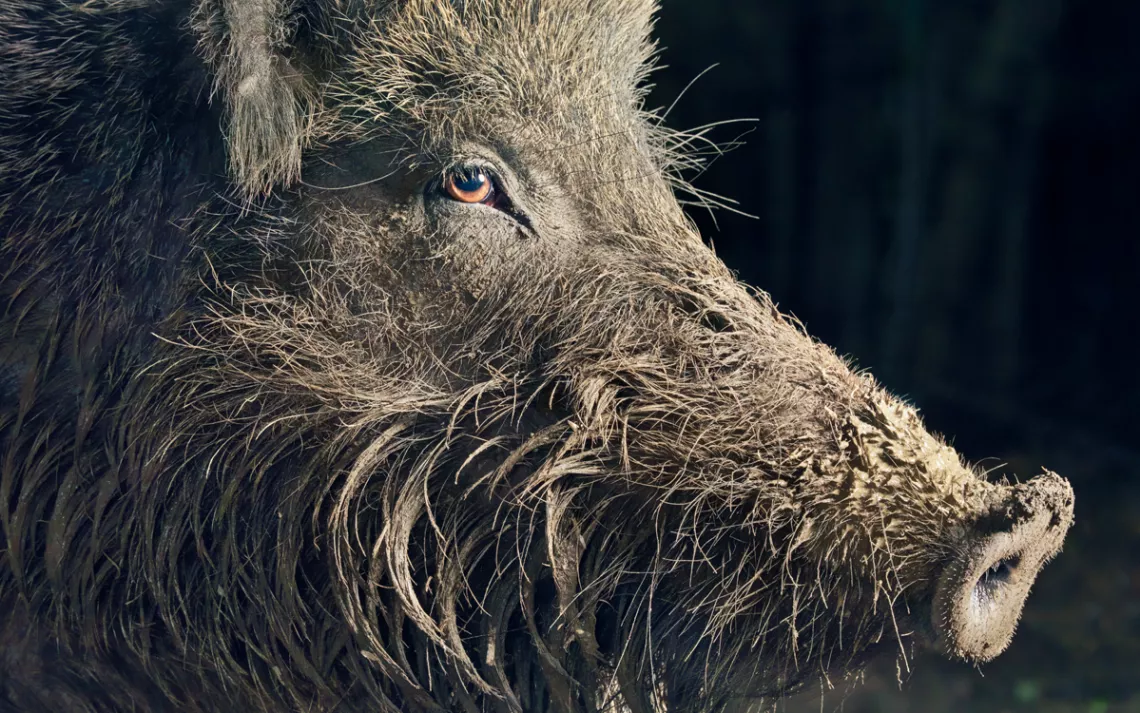Humans Have a Rival When It Comes to Ecological Mayhem
This little piggy has quite a rap sheet

Photo by Tim Flach
Considering the mess humans have made of things, we might feel a grudging affinity with scruffy Sus scrofa, the wild pig. Omnivorous, obstreperous, and obnoxious, feral swine join Homo sapiens in being among the most destructive species on the planet. They come in two varieties: genuine Eurasian wild boars and escaped or abandoned domesticated porkers. Within a couple of generations in the wild, the latter develop darker skin, sprout bristles, and grow tusks up to seven inches long. The two types interbreed with gusto. Sows are sexually mature at six months and can farrow twice a year, birthing four to 12 piglets at a go, over an average life span of four to eight years. Do the math: That's a lot of pigs, more than 6 million in the United States alone.
Wild pigs' astonishing fecundity allows them to quickly fill vacant ecological niches, such as evacuation zones around melted-down nuclear reactors. Twenty-two years after the 1986 Chernobyl incident, radioactive swine boasted cesium levels as high as 37,000 becquerels per kilogram. (The limit for human consumption in Germany is 600.) Wild boars moved into the exclusion zone around the Fukushima Daiichi nuclear power plant after its 2011 meltdown, occupying vacant homes, plowing up fields, and attacking visiting humans, which complicated efforts to persuade former residents to return home.
Boars are not picky eaters. When fully grown, they consume 3 percent of their body weight a day in field crops, frogs, reptiles, birds, and small mammals like lambs and calves. Boars have even been known to dig up corpses from graveyards. Their classic food is mast—the fallen acorns and chestnuts essential to Spain's jamón Ibérico—but pigs love to root for roots, bulbs, grubs, and what have you. A study in Global Change Biology estimated that each year, feral pigs worldwide uproot an area the size of Taiwan. Disturbing so much soil releases an enormous amount of carbon dioxide—as much as the yearly emissions of 1.1 million cars. In addition, all that rooting, wallowing, and trampling destroys wetlands and riparian areas, contributing to the decline of more than 250 threatened and endangered species.
Wild pigs also carry 20 diseases transmissible to humans, including tuberculosis, hepatitis, and influenza. They contaminate drinking water with five pathogens: E. coli, Campylobacter, Salmonella, Cryptosporidium, and Giardia. In addition, wild pigs threaten their domestic cousins with the incurable, deadly, and highly contagious African swine fever. In a desperate attempt to preserve its pork industry, Denmark installed a 43-mile fence along its border with Germany to keep wild boars out, thus far with some success.
What is to be done about these invasive, oversexed, disease-ridden, globe-warming, habitat-destroying creatures? We also need to figure out what to do about the pigs.
This article appeared in the Winter quarterly edition with the headline "Masters of Destruction."
In 2007, wild pigs were successfully eradicated from Santa Cruz Island off California at a cost of $5 million.
Christopher Columbus introduced pigs to the Americas; they were brought by Hernando de Soto to Florida and by Spanish missionaries to California.
In 2020, a wild boar in Berlin won fame by stealing a bag containing a laptop from a nudist sunbather, who gave chase.
 The Magazine of The Sierra Club
The Magazine of The Sierra Club



